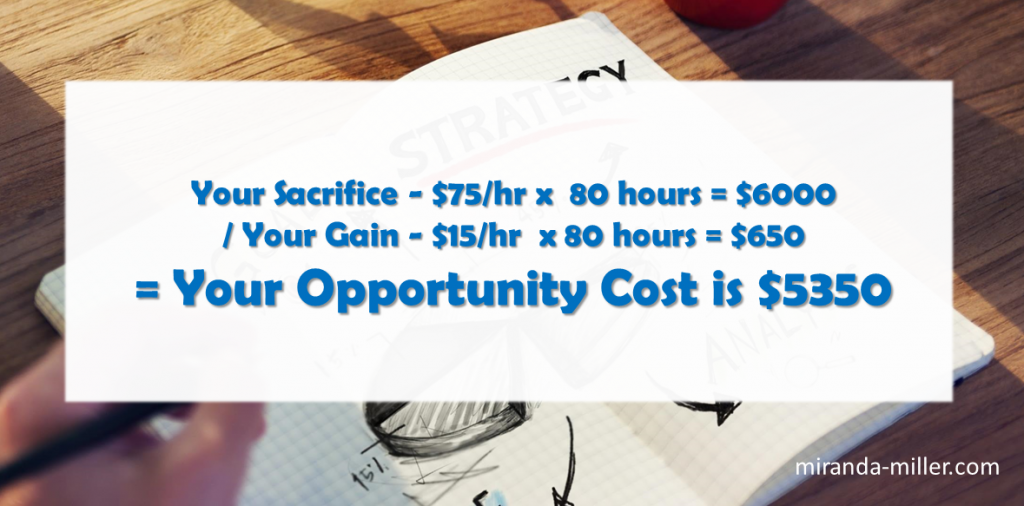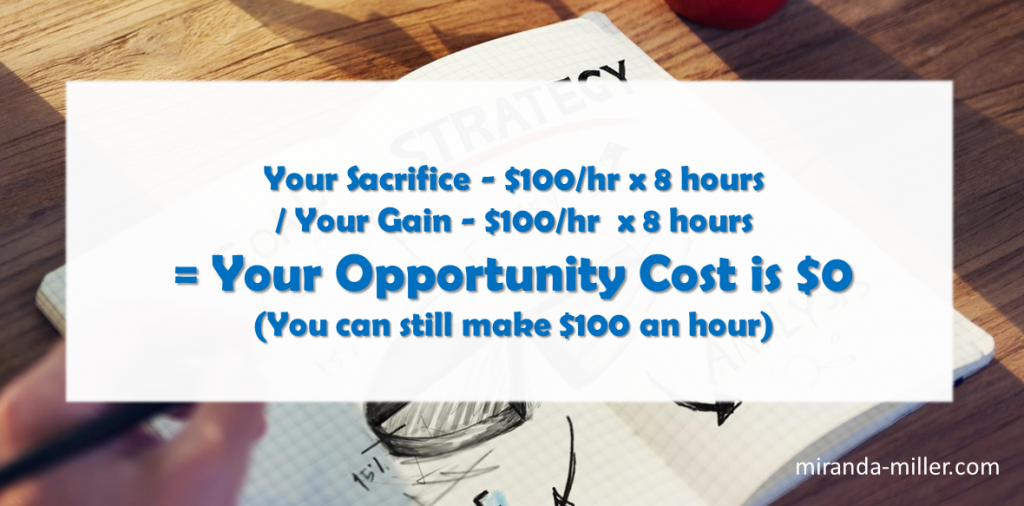The Cost of Saying Yes to Every Gig
How turning down projects can help you build your freelance writing business.
by Miranda Miller
Opportunity cost dictates that even when you make the best choice possible, you lose out on the benefits of the next best option.
We see this constantly as we move through life, in everything from grocery shopping to deciding which book to read to choosing a route to drive to work. When you pick your life partner, you’ve said no to all others (I hope). Every time you choose to do something, you’ve chosen not to do something else.
As confident as we are in our choices, understanding the loss of the next best choice gives valuable perspective, especially in business. Considering opportunity cost as part of our decision-making process helps us make the best choices possible.
Microeconomics was one of my favourite courses in university, not because I understood the value of it then, but because I learned early on that it was heavy on theory and light on actual numbers. Opportunity cost isn’t a complicated mathematical formula, but a way of weighing your options as you make decisions around the types of gigs you choose to accept.
In my last column, we looked at different tactics for growing your freelance writing business in 2015. Now, let’s look at the theory of opportunity cost and how you can apply it in your business, not only to make good decisions for growth, but to help you avoid costly mistakes that can hold you back.
How does opportunity cost work in freelance writing?
As humans, our daily decisions number in the thousands – should I cross the road? Should I eat now? Should I get divorced? Should I join a baseball team? These decisions vary in complexity and in the level of effort and analysis we put into each one. The vast majority are simple and are informed by our knowledge and experience. Our brain is trained to take “mental shortcuts” and propose intuitive solutions as we face myriad challenges and situations each day.
This is called heuristics: an approach to problem solving and decision making that relies on judgment, common sense and/or experience to make a decision that may not be perfect, but will suffice. Can you imagine how overwhelming it would be to consciously think through every potential consequence of every decision?
Sometimes, the decisions we need to make are more difficult and do warrant the extra thought. Yet you’re making decisions in your business all day long and I bet you aren’t really thinking about half of them. You’re used to doing things a certain way – to spending your time doing specific tasks – and are relying on your automatic decision-making habits.

I don’t blame you; you can’t think everything to death, or you’ll never get anything done. However, I want you to consider the simple formula above and start reflecting on it as you go about planning your day or week. When you’re pitching or pricing a potential gig, negotiating the terms of a contract, or even deciding how you’ll fill empty hours in your calendar, I want you to consider the opportunity cost.
After all, it’s our gut instinct as freelancers to fill the calendar and bill those hours. It’s how we survive. We want to fill the calendar and keep clients happy and it’s just crazy to say no to paying work when those hours are unaccounted for, right?
That’s an excellent survival strategy, but saying yes to everything is a terrible way to grow your business.
The simple formula above encourages us to consider, as we make business decisions, the values of both what we produce and what we sacrifice by choosing one path over another.
Let’s look at some different freelance business scenarios and see how this works.
Accepting gigs for less pay
It’s tempting to consider a gig offering less than your typical rate when you’re staring at the calendar and don’t see any other way of filling those hours. Say you’ve been asked to take on a $15/hourly project for 8 weeks, 10 hours per week. You might think your opportunity cost looks something like this:

The cost of accepting this opportunity is nothing, because you weren’t billing those hours anyway, right?
Wrong.
It may be an instinct – a reflex, the intuitive answer – that something is better than nothing and therefore you aren’t losing anything by taking $15 an hour instead of $75.
This is where opportunity cost isn’t an exact science, but is important to consider. Your time is scarce; once those hours are booked, they’re gone. Now, a $75/hour contract isn’t likely to fall into your lap, but booking out those 10 hours per week means you don’t have them to pitch or look for better gigs, either.
Look at it this way: the total value of that contract at $15 per hour is $600. The total value of those hours at your regular rate is $6000.
There’s no guarantee you would have landed a job at your regular rate to make the full $6000 in that time period. But by saying yes to the lower paying gig, you’ve guaranteed you won’t make any more than $650 for those hours. The actual cost is something you’ll never know, but it’s somewhere in that range between $650 and $5350. Ouch.
Accepting gigs outside of your niche or regular service menu
I saw an interesting example of opportunity cost recently in a writers’ forum I frequent. A freelancer had been asked by an existing client to put in a proposal for blog writing. This was outside of the writer’s typical service offering, but they felt it would serve their client well to give them what they wanted. After all, they reasoned, they could probably write blog posts fairly quickly.
I’ve yet to see a business pay their bloggers by the word. Most want to pay per blog post, so the writer needed to put together a package.
In our discussion, we learned that the company lacked internal marketing supports; it was their first crack at blogging and they hadn’t yet developed a content plan or blog strategy. Who do you think that would fall on? I’m going to go out on a limb and say they expected their writer to help them come up with the blog topics they would write about.
Of course, they’re going to need images, too. Some posts will require more research than others. Someone needs to figure out who the audience is and optimize the posts for search. And someone is going to have to get them into WordPress…
In these types of situations, where a client (either new or existing) is asking you to do something outside of your comfort zone, you absolutely need to consider the opportunity cost by the hour.
It may only have taken the writer one hour to write each blog post, yet it would have been a mistake to agree to the client’s (completely made up for illustrative purposes) offer of $800 per month for 8 blog posts. Sure, $100 a blog post sounds okay if it takes you one hour and therefore your hourly rate is maintained. Your opportunity cost, if you even go so far as to think about it, may look something like this:
You’re not losing anything by taking this different type of project and switching it up – not at a glance, anyway. However, there’s no accounting for the creation and management of the editorial calendar; for market and keyword research; for performance measurement; for managing the client account and providing support, etc.
Always, always consider every aspect of the project. The actual writing may be only a portion of what you’re agreeing to and it’s your responsibility to know the expectations before you sign on. Failing to understand everything involved in a gig can make it a nightmare of misunderstandings and additional hours. You could always refuse the additional tasks, but you’re going to be pretty frustrated with no idea what you’re supposed to write about or who you’re trying to reach. It becomes a no-win.
In this case, when you factor in all of the blogging functions that would be required to actually write the posts and do a good job of them, your opportunity cost may look more like this:
Again, you’re committing to spending hours at a lower rate and in doing so, making yourself unavailable for more lucrative opportunities.
There are more valuable ways to spend your time…
Don’t say yes automatically because you don’t have any other gigs on the calendar. Other things you could be doing that offer far more value to your business include:
- Building your presence on Twitter, Facebook and LinkedIn
- Participating in a Twitter chat, LinkedIn Group discussion or webinar
- Taking a Lynda course (CMG Freelance members get free access)
- Scanning job boards, RFPs and freelance classifieds for prospects
Each of the above actions is another variable in your opportunity cost equation. Even if you don’t have a job lined up to fill the empty 15 hours on your calendar, you’re saying no to marketing, to education, to seeking out other opportunities if you accept a low hourly rate just to stay busy. The exact monetary cost is impossible to predict, but the cost to your business growth is obvious.
It’s too easy to stay busy being busy – get busy pitching and preparing yourself for those gigs that not only pay what you’re worth, but help further your freelance writing business goals.
Do you have questions about the business of freelance writing? Tweet me or leave a comment below.







on March 27, 2015 at 5:06 am
· Permalink
What a great reminder to step back and consider what options we rule out by listening to the fear of no-income hours or letting the reflex of saying yes decide for us!
on March 27, 2015 at 1:06 pm
· Permalink
Thank you, Charlotte! I’m glad you enjoyed it.
on March 30, 2015 at 12:46 pm
· Permalink
Good stuff! Great advice that all freelancers (and businesses!) need to consider, Miranda. We’re on an aggressive growth plan and this was one of the difficult hurdles we had to overcome… the tendency to try to fill the calendar with work… any work.
on March 31, 2015 at 3:24 pm
· Permalink
The second example you used was quite interesting (blog writing). I have freelanced since 1985 and have seen, obviously, a ton of changes. Now, I hate how little bloggers seem to get paid, or how little social media managers are paid to run campaigns. However, we can’t deny that of the considerable amount of money out there for (especially) corporate communications, that a lot of that money is being ‘re-allotted’ to bloggers and social media, and that is money that is likely being SIPHONED OFF trad ways of earning a living. Blogging is probably like many business ventures, you might lose a ton of dough for the first six months, but then it might provide a springboard to either a) a more lucrative (hmm, hard to say) or b) consistent (more likely, because it will be set according to a retainer) income path. (One might also argue that taking on all of the various functions of blogging – finding the photos, doing the keywords, running the analytics – might be eating into your creative time, and it likely is. Blogging generally seems to be about immediacy and mere ‘information providing’ first, storytelling, style, and even entertainment, second.
on April 13, 2015 at 3:13 am
· Permalink
I really like the formula you provided for us, and this analogy is brilliant.Thanks for clarifying one of the most important things freelancers struggle nowadays.